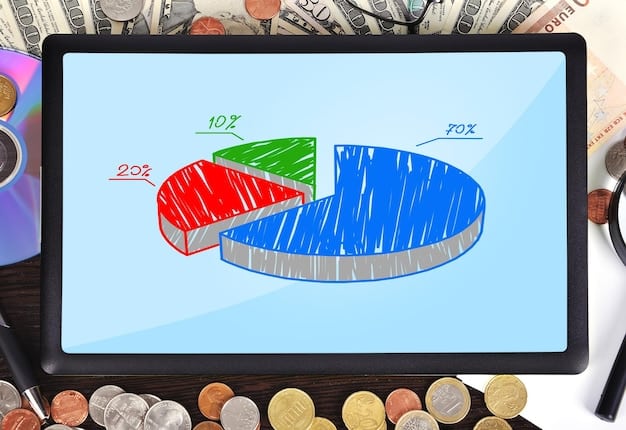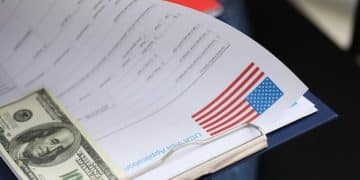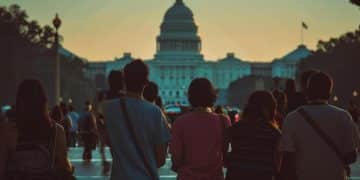Unlock Financial Aid: Your Step-by-Step Guide to Loan Forgiveness Programs

Unlock Financial Aid: A Step-by-Step Guide to Federal Student Loan Forgiveness Programs provides a comprehensive overview of available programs, eligibility requirements, and the application process, empowering borrowers to navigate the system and potentially reduce or eliminate their student loan debt.
Navigating the world of student loans can be daunting, but understanding your options for forgiveness is crucial. This guide will provide a step-by-step approach to unlock financial aid through federal student loan forgiveness programs.
Understanding Federal Student Loan Forgiveness Programs
Federal student loan forgiveness programs offer a lifeline to borrowers struggling to repay their student debt. These programs, often administered by the Department of Education, provide avenues for borrowers to have a portion or all of their federal student loans canceled.
These initiatives are not mere handouts; they are designed to support individuals who have dedicated their careers to public service or meet specific economic hardship criteria.
Types of Federal Student Loan Forgiveness Programs
Several federal programs offer student loan forgiveness, each with its own set of requirements and benefits.
- Public Service Loan Forgiveness (PSLF): For individuals employed by qualifying government or non-profit organizations.
- Teacher Loan Forgiveness: Available to teachers who serve in low-income schools for a specified period.
- Income-Driven Repayment (IDR) Forgiveness: After 20 or 25 years of qualifying payments under an IDR plan.
Eligibility Requirements for Forgiveness
Meeting the eligibility criteria is paramount to accessing federal student loan forgiveness. These requirements vary depending on the specific program, but generally include factors such as employment type, loan type, and adherence to repayment plans.
Understanding these requirements is the first step towards navigating the forgiveness pathway.

In summary, understanding these programs will give you a good foundation into whether you may be eligible for these programs or not. The next section will dive into the steps of applying to these programs.
Step-by-Step Guide to Applying for Loan Forgiveness
Applying for federal student loan forgiveness can seem complex, but breaking it down into manageable steps can make the process more approachable. This section provides a detailed roadmap to guide borrowers through each stage.
From gathering necessary documentation to submitting the application, following these steps can increase your chances of a successful outcome.
Step 1: Research and Identify Eligible Programs
Begin by thoroughly researching available federal student loan forgiveness programs and identifying those for which you may be eligible. Consider factors such as your employment sector, loan type, and repayment plan.
- Visit the Department of Education’s website to explore different forgiveness options.
- Use online tools and calculators to estimate potential forgiveness amounts.
- Consult with a financial advisor or student loan counselor for personalized guidance.
Step 2: Gather Necessary Documentation
Once you’ve identified potential programs, gather all required documentation. This may include employment verification forms, loan statements, tax returns, and proof of income.
Having all necessary documents readily available will streamline the application process.
Step 3: Complete and Submit the Application
Carefully complete the application form for the chosen forgiveness program, ensuring all information is accurate and up-to-date. Submit the application along with any required supporting documentation to the appropriate agency or loan servicer.
Review all fields to prevent common issues or hang ups within the form.
This section is a good guideline to use in order to successfully apply. The key takeaway is knowing what programs are available and what documentation you need.
Navigating Income-Driven Repayment (IDR) Forgiveness
Income-Driven Repayment (IDR) plans offer a unique pathway to student loan forgiveness by basing monthly payments on a borrower’s income and family size. After a specified period of qualifying payments, any remaining loan balance may be forgiven.
Understanding the nuances of IDR forgiveness is essential for borrowers seeking long-term relief from student loan debt.
How IDR Forgiveness Works
IDR forgiveness is granted after 20 or 25 years of qualifying payments under an IDR plan. The specific repayment period depends on the type of loan and the chosen IDR plan.
It’s important to note that the forgiven amount may be subject to income tax.
Choosing the Right IDR Plan
Selecting the most suitable IDR plan is crucial for maximizing forgiveness benefits. Options include Income-Based Repayment (IBR), Pay As You Earn (PAYE), and Saving on a Valuable Education (SAVE), each with its own eligibility criteria and payment calculation methods.
- Calculate your estimated monthly payments under various IDR plans.
- Consider your long-term income prospects and career trajectory.
- Seek professional advice to determine the most advantageous plan for your circumstances.

Understanding the various IDR plans and picking the right one for your situation is important if you choose this avenue. Doing so may benefit you substantially.
Public Service Loan Forgiveness (PSLF): A Detailed Look
Public Service Loan Forgiveness (PSLF) is a program designed to alleviate student loan debt for individuals employed by qualifying government or non-profit organizations. After 10 years of qualifying employment and 120 qualifying payments, borrowers may be eligible to have their remaining federal student loan balance forgiven.
This program is a beacon of hope for those dedicated to serving their communities.
Qualifying Employment for PSLF
To be eligible for PSLF, borrowers must be employed full-time by a qualifying employer, which includes government organizations at any level (federal, state, local, or tribal) and certain non-profit organizations that are tax-exempt under Section 501(c)(3) of the Internal Revenue Code.
Some non-profit organizations that are not tax-exempt may also qualify if they provide certain public services.
The 120 Qualifying Payments Requirement
Borrowers must make 120 qualifying payments while employed by a qualifying employer to be eligible for PSLF. These payments must be made under a qualifying repayment plan, such as an Income-Driven Repayment (IDR) plan.
Payments made under the standard 10-year repayment plan do not qualify for PSLF.
The PSLF offers substantial help to individuals who choose careers in public service. Choosing this option can really help forgive student loan debt for qualifying individuals.
Common Mistakes and How to Avoid Them
Navigating the complex landscape of federal student loan forgiveness programs can be fraught with challenges, and borrowers often make common mistakes that can jeopardize their eligibility. This section highlights these pitfalls and provides practical advice on how to avoid them.
By being aware of these potential issues, borrowers can take proactive steps to safeguard their chances of obtaining loan forgiveness.
- Failing to meet eligibility requirements: Carefully review all program requirements and ensure you meet them before applying.
- Submitting incomplete or inaccurate applications: Double-check all information and provide all required documentation.
- Not keeping records of payments and employment: Maintain detailed records for verification purposes.
Seeking Professional Guidance
Navigating the complexities of student loan forgiveness can be overwhelming, and borrowers may benefit from seeking professional guidance. Financial advisors and student loan counselors can provide personalized advice, help borrowers understand their options, and assist with the application process.
There are several resources available and its important to note common mistakes so they can be avoided.
Staying Updated on Policy Changes and New Programs
The landscape of federal student loan forgiveness programs is constantly evolving, with policy changes and new initiatives being introduced regularly. Staying informed about these developments is crucial for borrowers seeking to maximize their benefits.
By being proactive and keeping abreast of the latest news, borrowers can ensure they’re taking advantage of all available opportunities.
Resources for Staying Informed
Several resources can help borrowers stay updated on policy changes and new programs. These include:
The Department of Education’s website:
- Industry news outlets.
- Student loan advocacy groups.
Sign up for email alerts and newsletters to receive regular updates on student loan forgiveness programs.
Its important to always stay on top of the newest trends and changes to student loans so you can keep yourself well-informed to make the best decisions. This information is crucial to making the best judgements needed.
| Key Point | Brief Description |
|---|---|
| 🔑 PSLF Program | Forgives loans for public service employees after 10 years. |
| 💰 IDR Forgiveness | Forgives loans after 20-25 years under income-driven repayment plans. |
| 📝 Application Steps | Research, gather documents, and submit the application carefully. |
| 🚨 Avoid Mistakes | Ensure eligibility and keep detailed records to prevent errors. |
Frequently Asked Questions
▼
PSLF forgives the remaining balance on your Direct Loans after you’ve made 120 qualifying payments while working full-time for a qualifying employer, typically a government or non-profit organization.
▼
IDR plans base your monthly student loan payments on your income and family size. After 20-25 years of qualifying payments, the remaining balance may be forgiven, though it might be taxable.
▼
Qualifying employment includes working full-time for a U.S. federal, state, local, or tribal government, or a non-profit organization that is tax-exempt under Section 501(c)(3) of the Internal Revenue Code.
▼
You can use the PSLF Help Tool on the Federal Student Aid website to check if your employer qualifies. This tool helps determine eligibility and guides you through the PSLF process.
▼
The forgiven amount under IDR plans may be considered taxable income by the IRS. However, PSLF forgiveness is generally not taxable under current federal law. Consult a tax professional for personalized advice.
Conclusion
Understanding and accessing federal student loan forgiveness programs can significantly ease the burden of student debt. By researching available options, carefully following the application steps, and staying informed about policy changes, borrowers can take control of their financial future and pursue their goals with greater confidence.





